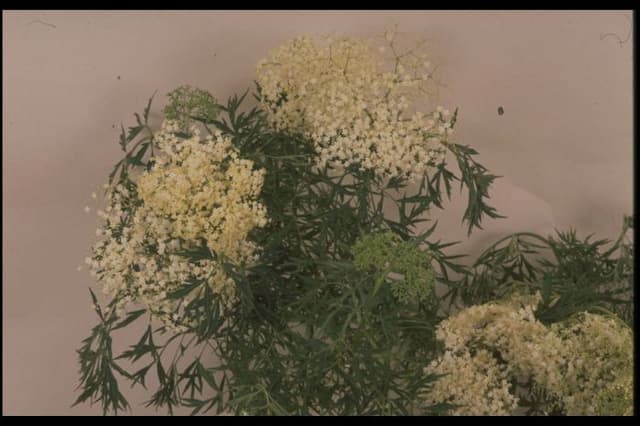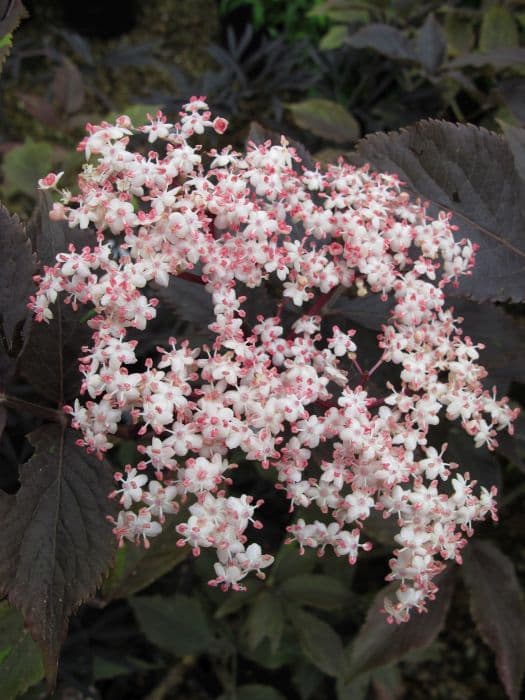Wayfaring tree Viburnum lantana

ABOUT
The common name for Viburnum lantana is Wayfaring Tree. This deciduous shrub is recognized for its broad, spreading habit and its rich green foliage. The leaves are somewhat heart-shaped, with a rounded base, and have a somewhat wrinkled texture with a toothy edge, which contributes to its distinctive look. During the spring, it blooms with clusters of creamy white flowers that come together in flat-topped groupings known as cymes. These blossoms give way to berry-like fruits that mature to a red and eventually turn to a deep, bluish-black color. The bark of this plant is gray to brown and develops a rough, textured appearance as it ages. Wayfaring Tree is also known for its ability to thrive in a multitude of different environmental conditions, adapting well to various soil types and levels of sun exposure.
About this plant
 Names
NamesFamily
Adoxaceae.
Synonyms
Wayfaring Tree, Wayfaring Bush, Hoarwithy, Mealy Tree.
Common names
Lantana vulgaris, Viburnum lantana var. variegatum, Viburnum lantana f. albescens, Viburnum lantana f. aureo-variegatum, Viburnum lantana f. leucocarpum, Viburnum lantana f. lucidum, Viburnum lantana f. nanum, Viburnum lantana f. pubescens, Viburnum lantana f. roseo-variegatum, Viburnum lantana f. variegatum.
 Toxicity
ToxicityTo humans
The Wayfaring Tree can be toxic to humans if ingested. The plant, especially its berries, contains toxic compounds that can cause mild to moderate symptoms upon consumption. The symptoms of poisoning from the berries may include nausea, vomiting, diarrhea, and stomach cramps. Although it's toxic, it is rarely life-threatening to humans. Caution should be exercised to prevent children from consuming the berries.
To pets
The Wayfaring Tree can also be toxic to pets if ingested. Just like in humans, the plant contains compounds that can cause gastrointestinal distress. Symptoms of poisoning in pets may include vomiting, diarrhea, and lethargy. It is important to prevent pets from eating parts of the plant, especially the berries, to avoid potential health issues.
 Characteristics
CharacteristicsLife cycle
Perennials
Foliage type
Deciduous
Color of leaves
Green
Flower color
White
Height
10-15 feet (3-4.5 meters)
Spread
10-15 feet (3-4.5 meters)
Plant type
Shrub
Hardiness zones
4-8
Native area
Europe
Benefits
 General Benefits
General Benefits- Landscape Aesthetics: Viburnum lantana, commonly known as wayfaring tree, provides visual interest to gardens and landscapes with its lush foliage, attractive white flowers in spring, and clusters of red to black berries in the fall.
- Wildlife Habitat: The berries provide a valuable food source for birds and other wildlife, while the dense foliage offers shelter and nesting sites.
- Erosion Control: Its extensive root system can help stabilize soil, combating erosion on slopes and disturbed areas.
- Drought Tolerance: Once established, this plant has good tolerance to drought, making it suitable for xeriscaping and reduced-water landscaping.
- Screening Plant: With its dense growth habit, wayfaring tree can be used as a natural screen or hedge for privacy and wind protection.
- Adaptable Growth: This deciduous shrub can thrive in a variety of soil types and conditions, making it versatile for various garden environments.
- Seasonal Interest: Provides year-round interest with its changing foliage, flowers, and fruit throughout the seasons.
 Medical Properties
Medical Properties- Anti-inflammatory: Viburnum lantana has been used in traditional medicine for its potential anti-inflammatory properties.
- Antispasmodic: It may help to relieve muscle spasms.
- Astringent: The plant has astringent qualities, which can be useful in tightening tissues and reducing secretions.
- Sedative: Historically, the plant has been used to promote relaxation and as a mild sedative.
- Antirheumatic: Viburnum lantana has been traditionally used to ease symptoms associated with rheumatic conditions.
 Air-purifying Qualities
Air-purifying QualitiesThis plant is not specifically known for air purifying qualities.
 Other Uses
Other Uses- Viburnum lantana's branches can be used for making tool handles as the wood is strong and resilient.
- The wood of Wayfaring tree can be utilized in woodworking for creating small carvings and intricate pieces.
- Its dense foliage provides excellent nesting sites for birds, making it a valuable plant for supporting local wildlife.
- Wayfaring tree can be planted as a windbreak in gardens or agricultural settings due to its robust nature and dense growth habit.
- The berries are sometimes used for making inks and dyes, thanks to their deep blue-black color when ripe.
- Because of its attractive flowers and berries, Viburnum lantana is used for ornamental purposes in landscaping.
- Its leaves can be mulched to provide a natural soil conditioner, enriching garden soil with organic matter.
- Viburnum lantana hedges can serve as a natural barrier to livestock, offering a farm-friendly fencing alternative.
- The dried flower clusters might be utilized in floral arrangements and crafts for their texture and shape.
- In permaculture designs, Wayfaring tree can be incorporated as part of a forest garden, offering both aesthetic value and habitat for beneficial insects.
Interesting Facts
 Feng Shui
Feng ShuiThe Wayfaring Tree is not used in Feng Shui practice.
 Zodiac Sign Compitability
Zodiac Sign CompitabilityThe Wayfaring Tree is not used in astrology practice.
 Plant Symbolism
Plant Symbolism- Renewal: Viburnum lantana, commonly known as Wayfaring Tree, marks the coming of spring with its blossoms, symbolizing new beginnings and renewal.
- Protection: The dense foliage and the fact that it was often planted near dwellings for its shielding ability associate it with protection.
- Abundance: The plant produces a large number of fruits, which can symbolize abundance and generosity.
 Water
WaterThe Wayfaring Tree, or Viburnum lantana, prefers even moisture and should be watered thoroughly whenever the top inch of soil feels dry to the touch. In the growing season, this might translate to once a week, but it's essential to adjust based on rainfall and temperatures. Deep watering, where water reaches down to the roots, is recommended rather than frequent shallow waterings. For a newly planted Wayfaring Tree, you might need to water with about 2 gallons weekly until it establishes. During the winter months, reduce watering as the plant goes dormant and requires less moisture.
 Light
LightThe Wayfaring Tree thrives in full sun to partial shade conditions. Ideally, it should receive at least four to six hours of direct sunlight a day. An eastern or western exposure with some afternoon shade would be the best spot for the Wayfaring Tree to protect it from the intense late-day sun, while still providing the light it needs to grow and bloom.
 Temperature
TemperatureThe Wayfaring Tree is quite adaptable but prefers a temperature range between 65°F and 75°F for optimal growth. It can tolerate minimum temperatures down to around -10°F and maximum temperatures up to approximately 95°F. Placing your Wayfaring Tree in a location where it can avoid extreme heat or cold will help ensure its health and longevity.
 Pruning
PruningPruning the Wayfaring Tree is important to maintain its shape and encourage healthy growth. Pruning should be done in late winter or early spring before new growth starts. It's usually sufficient to prune once per year, cutting back any old, diseased, or overcrowded branches. Pruning can also help to maintain a desired size or to rejuvenate an older plant.
 Cleaning
CleaningAs needed
 Soil
SoilWayfaring tree thrives in well-draining soil enriched with organic material, having a slightly acidic to neutral pH between 5.6 and 7.5. A mix containing loam, garden compost, and a bit of sand or perlite to ensure good drainage will create an ideal growing medium for this shrub.
 Repotting
RepottingWayfaring trees, when grown in containers, should be repotted every 2-3 years to prevent root crowding and to replenish nutrients in the soil. Use a larger pot each time to accommodate the growing root system.
 Humidity & Misting
Humidity & MistingWayfaring tree isn't particularly humidity-sensitive and can adapt to a wide range of humidity conditions. Average outdoor humidity levels are typically suitable for this hardy shrub.
 Suitable locations
Suitable locationsIndoor
Provide bright light, well-draining soil, and periodic watering.
Outdoor
Plant in well-drained soil with full sun to partial shade.
Hardiness zone
5-8 USDA
 Life cycle
Life cycleViburnum lantana, also known as Wayfaring Tree, begins its life cycle as a dormant seed, which germinates in the spring when soil temperatures and moisture levels become suitable. The seedling emerges and develops into a young plant, establishing a root system and producing leaves to photosynthesize. As it matures, Viburnum lantana develops woody stems and can form a shrub reaching up to 4-5 meters in height. It flowers in late spring to early summer, producing dense clusters of cream-white, fragrant flowers that attract pollinators. Following pollination, the flowers develop into small red drupes that ripen to black, which are then dispersed by birds and mammals, completing the reproductive cycle. The plant can also spread vegetatively through suckering, creating clonal thickets.
 Propogation
PropogationPropogation time
Spring-Early Summer
The most popular method of propagating the Wayfaring Tree (Viburnum lantana) is by softwood cuttings. This typically occurs in late spring or early summer when new growth is tender but has not yet hardened. Cuttings should be about 4 to 6 inches (10 to 15 centimeters) long and include several sets of leaves. The bottom set of leaves is removed, and the cut end is dipped in rooting hormone before being inserted into a well-draining rooting medium, such as a mix of peat and perlite. The cutting should be kept moist and in a warm environment with indirect light. Roots usually develop in a few weeks, after which the cuttings can be transplanted to individual pots or directly into the garden.









